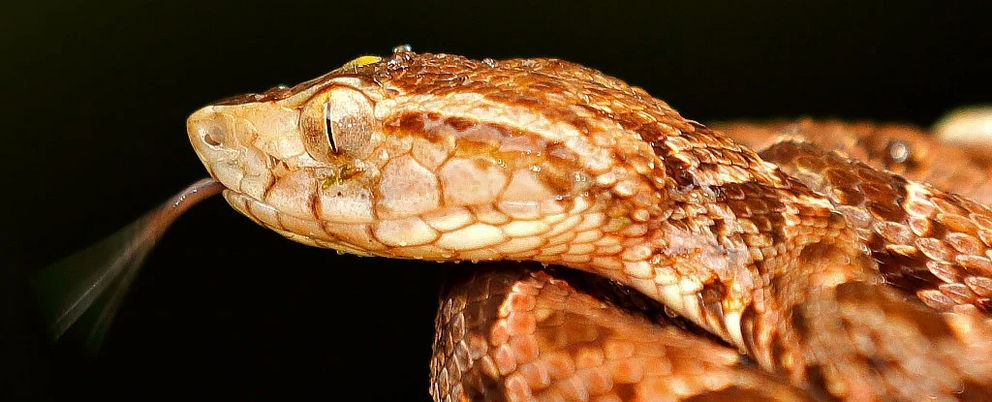Snake-venom 'super glue' can stop wounds bleeding in seconds with a flash of light
Common lancehead pit viper
Venom's usually the stuff of nightmares. Animals that wield it send instinctive shivers down our spines.
But scientists are teasing out useful purposes for these powerful substances that (sometimes incidentally) can cause us so much pain and damage. Recently we've seen developments from several types of venoms, from bee venom as a cancer treatment to using platypus venom for diabetes.
A team of researchers has developed the next venom-based medical advancement: a fast-acting "super glue" that stops bleeding in under a minute.
While synthetic adhesives can be easier to manipulate, their degradation can potentially be toxic. Meanwhile, natural bioadhesives are more likely to "have excellent biocompatibility", explained the authors in their new paper, but limited overall integrity and adhesion.
To remedy those failings, researchers crafted a bioadhesive gel that includes the venom of the common lancehead pit viper (Bothrops atrox).
One of the most venomous snakes in the region, the common lancehead pit viper stalks tropical lowlands of South America for small mammals, birds, and reptiles, which it takes down with venom that destroys their vascular systems.
The venom causes excessive clotting until the prey's body exhausts its capacity to form any clots at all and ends up bleeding excessively instead, a process called consumption coagulopathy.
Scientists extracted the molecule reptilase (or batroxobin) responsible for the blood clotting. This enzyme is already used in laboratory diagnostic tests to measure fibrinogen levels – a molecule produced in our livers that our bodies convert for use in blood clots.
Building on past research, the team added reptilase into a methacrylated gelatin to develop it into a fast-acting tissue adhesive. The gelatin previously showed promise in the way it can be controlled and set using light but was not able to stick well in the presence of blood. The addition of reptilase sorted that out quickly.
"During trauma, injury, and emergency bleeding, this 'super glue' can be applied by simply squeezing the tube and shining a visible light, such as a laser pointer, over it for a few seconds. Even a smartphone flashlight will do the job," said Western University bioengineer and one of the study's authors Kibret Mequanint.
By rapidly converting fibrinogen into the clot-forming fibrin, reptilase could seal wounds in only 45 seconds, half the time of the current best option in the field called fibrin glue.
Researchers tested the glue on major bleeding wounds, like a deep skin cut and ruptured aorta, in rats. It didn't require any additional stitching or wash out with the blood.
"We envision that this tissue 'super glue' will be used in saving lives on the battlefield or other accidental traumas like car crashes," said Mequanint. "The applicator easily fits in first aid kits too."
The treatment, however, still has to undergo clinical trials before we can reach that point.
This is only one of many current investigations into using venom components to save lives.
Just this week, another team published research that shows spider venom has the potential to aid heart attack victims.
The small protein, Hi1a, from the Fraser Island funnel-web spider, is able to stop the signal for cell death caused by oxygen deprivation. The team demonstrated they could use it to keep beating heart cells in the lab alive for longer.
"For people who are literally on death's door, this could be life-changing," said Peter Macdonald from the Victor Chang Cardiac Research Institute.
Earlier this year, University of Vienna chemist Markus Muttenthaler and colleagues reviewed the exploration of biomolecules like those derived from venoms and found more than 150 peptides are currently in clinical development, with up to 600 in preclinical studies.
Systematic exploration of animal venoms "allows us to take advantage of the vast natural and over millions of years evolutionary-selected peptide libraries for therapeutic lead discovery," explained Muttenthaler, whose own work has investigated spider and scorpion venom use for chronic pain relief.
As work continues towards the hopeful transformation of these substances into helpful products, so many natural biomolecules still remain unexplored. Yet the rampant destruction we're causing the natural world means treatments are likely becoming extinct along with the species they lie within before we'll even have the chance of discovering them.
The study was published in Science Advances.

